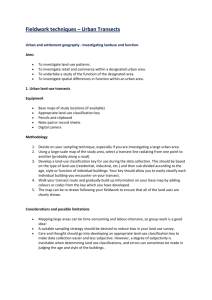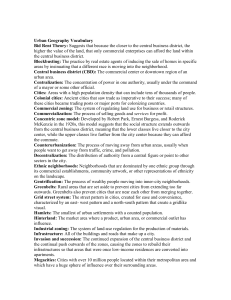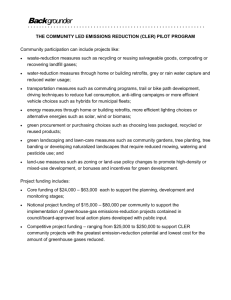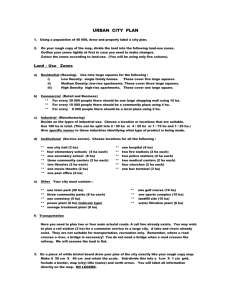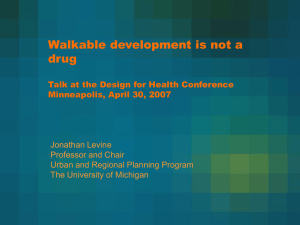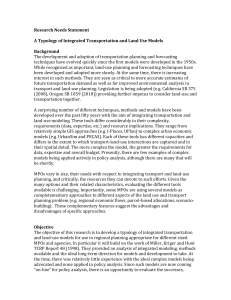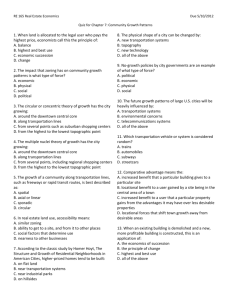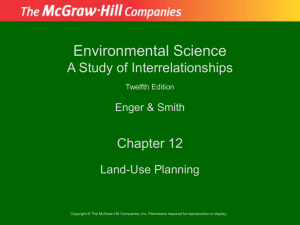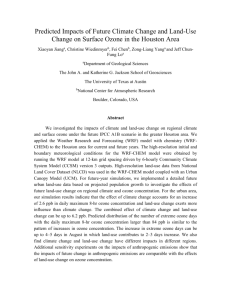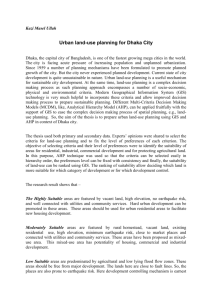Land-Use Planning Principles
advertisement
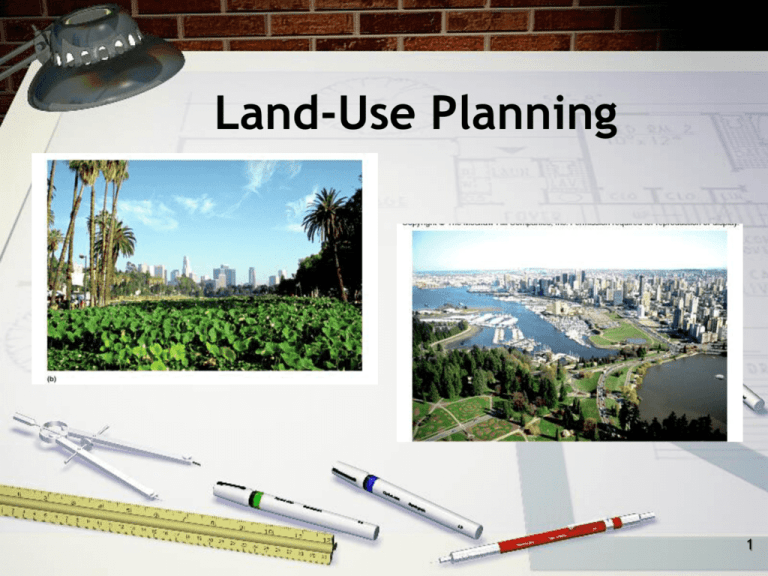
Land-Use Planning 1 • • • • Need for Planning Historical Forces Rural to Urban Shift Urban Sprawl Outline – Contributing Factors – Problems with Unplanned Growth • Land-Use Planning Principles – Urban Planning Issues – Smart Growth • Federal Government Land Use Issues 2 The Need For Planning • Between 1/3 - 1/2 world’s surface altered by humans. – Most land-use decisions are still based primarily on economic considerations or shortterm needs rather than on unique analysis of the landscape. – Once land has been converted to intensive human use, it is generally unavailable for other uses. 3 Historical Forces That Shaped Land Use in North America • Land Use in the United States: – 47% - Crops and livestock – 45% - Forests and natural areas – 5% - Intensive human use • Differs greatly from original conditions experienced by immigrants from New World. 4 Historical Forces That Shaped Land Use in North America • First U.S. colonists converted landscape to farming, and then to towns and cities. • Waterways provided primary method of transportation. – Allowed exploration and development of commerce. – Early towns usually built near water and at transfer points between water systems. 5 Water and Urban Centers 6 Rural to Urban Shift • North America remained essentially rural until industrial growth began in last 1/3 of 1800’s. • Industrial Revolution – Industrial jobs to be found in cities. • European Immigrants – Congregated in, and subdivided cities. • Offered variety of cultural, social, and artistic opportunities. 7 Migration from Central City to the Suburbs • Industrial Revolution led to polluted, undesirable waterways. – As roads and rail transport became more common, many left the waterway areas. • Agricultural land surrounding towns was converted to housing. – Land began to be viewed as a commodity, not as a nonrenewable resource to be managed. 8 Suburb Migration • As land prices in the city rose, people began to look for cheaper areas away from the city. – 1950 - 60% urban population lived in central cities. – 1990 - 30% urban population lived in central cities. 9 Rural-to-Urban Population Shift 10 Suburb Migration • Convenience and personal automobiles escalated decentralized housing patterns and diminished importance of mass transit. – Decreased energy efficiency. – Increased cost of supplying utility services. 11 Suburb Migration • Urban Sprawl - Pattern of un-planned low density housing and commercial development outside of cities. – Land-Use Practices: • Zoning ordinances that isolate employment and shopping services away from housing locations. • Low-density planning aimed at creating automobile access to increasing expanses of land. 12 Suburb Migration • Three types of urban sprawl: – Development of exclusive wealthy suburbs adjacent to the city. – Tract Development - Construction of similar residential units over large areas. – Ribbon Sprawl - Commercial / industrial buildings line highways connecting housing developments to central city. • Megalopolis - Merge of cities into large, urban areas. 13 Regional Cities 14 Factors That Contribute to Sprawl • Lifestyle – Increased wealth of population. • Decentralized housing pattern is possible because high rate of automobile ownership allows ease of movement. • Economic – Building on agricultural land less expensive. – Tax laws encourage home development. 15 Factors That Contribute to Sprawl • Planning and Policy – Historically, little coordination of effort. • Large number of political jurisdictions. – Zoning ordinances prohibit land use mixing. • Specify minimum lot and house sizes. – Government subsidies. • Local governments pay some costs of extending services into new areas. – Alleviates costs to builders. 16 Problems Associated with • Transportation Unplanned Growth – Little thought to transportation corridors. – Establishment of new corridors stimulates growth in nearby areas. • Reliance on automobiles has required constant road building. – In Los Angeles, 70% of city’s surface area dedicated to automobiles. • Average person in U.S. spends 9 hrs/wk in an automobile. 17 Problems Associated with Unplanned Growth • Air Pollution – As traffic increases, so does air pollution. • Low Energy Efficiency – – – – Automobiles are inefficient transportation. Decentralized cities - longer commutes. Stop and go traffic patterns. Single family homes less efficient. 18 Problems Associated with Unplanned Growth • Loss of Sense of Community – In many areas, people do not routinely walk through their neighborhood. • Death of Central City – Currently less than 10% of people work in the central city. • Less income to support public services. • Higher Infrastructure Costs – Extension of municipal services. 19 Problems Associated with Unplanned Growth • Loss of Open Space – Oftentimes open space planning left out of development plans. • Loss of Farmland – Flat, well-drained land ideal for both farmland and urban development. – Partial transformation often leads to whole transformation. 20 Problems Associated with Unplanned Growth • Water Pollution Problems – Large impervious surface areas lead to high runoff and potential flooding. • Floodplain Problems – Many cities located on floodplains. • Flat, nutrient rich. – Development increases economic losses. • Many communities have enacted floodplain zoning ordinances. 21 Problems Associated with Unplanned Growth • Wetlands Misuse – Many have been drained, filled, or used as landfills. • U.S. has lost 53% of wetlands since the European immigration began (Not including Alaska). – Wetlands play crucial role in reproductive phase of many organisms. » Provide sediment filtration. 22 Problems Associated with Unplanned Growth • Other Land-Use Considerations – Geological Status • Earthquake-Prone Faults • Unstable Hillsides • Fire-Prone Areas – Climate • Water Shortages 23 Land-Use Planning Principles • Land-Use Planning - Evaluating needs and wants of a population, as well as land characteristics and value, and various alternative solutions to land uses before changes are made. – Basic rule should be to make as few changes as possible. 24 Land-Use Planning Principles • Evaluate and record unique geological, geographic, and biologic features. • Preserve unique cultural or historical features. • Conserve open space and environmental features. • Calculate cost of additional changes required to accommodate altered land use. 25 Land-Use Planning Principles • Plan for mixed uses in close proximity. • Plan variety of transportation options. • Set limits and require managed growth patterns with compact development. • Encourage development in areas with existing infrastructure. 26 Mechanisms for Implementing Land-Use Plans • Establish State / Regional Planning Agencies. – More effective than larger agencies due to more logical natural boundaries. • Purchase Land or Use Rights. – In many cases, owner may be willing to limit future uses of the land. 27 Mechanisms for Implementing Land-Use Plans • Regulate Use – Zoning - Designating land for specific uses. • Often planners represent business or developing interests. 28 Special Urban Planning Issues • Urban Transportation Planning – Four Goals • Conserve energy and land resources. • Provide efficient / inexpensive transportation. – Target populations. • Provide efficient transportation opportunities to suburban residents. • Reduce urban pollution. 29 Urban Transportation Planning • Problems with Mass Transit – Only economical along heavily populated routes. – Extremely expensive to build / operate. – Often crowded and uncomfortable. – U.S. government encourages personal autos by financing highways, maintaining cheap energy policy, and not funding mass-transit projects (hidden subsidies). 30 Problems with Mass Transit • Mass transportation systems are often under-funded and difficult to establish because mass transit is: – Economically feasible only along heavily populated areas. – Less convenient than private automobiles. – Extremely expensive to build and operate. – Often crowded and uncomfortable. 31 Decline of Mass Transportation 32 Urban Recreation Planning • Nearly 3/4 of N.A. population lives in urban areas. • Until recently, urban parks were considered an uneconomical use of land. • Facilities not conveniently located may be infrequently used. – New outgrowth of urbanization is the development of urban nature centers. 33 Re-Development of Inner City Areas • Many industrial cities are plagued by high cost of cleanup and renovation of brownfields. – Vacant industrial and commercial sites. • Brownfield Development - Degree of clean-up required to support intended use of the site. • Another important focus is remodeling abandoned commercial buildings into shopping centers, cultural facilities, and high-density housing. 34 Smart Growth • Smart Growth recognizes benefits of growth. – Advocates emphasize developing “livable” cities and town. • Quality of environment directly affects quality of life. 35 Smart Growth • Smart Growth Principles – – – – – Mix land uses. Take advantage of compact designs. Create range of housing opportunities. Create walkable neighborhoods. Foster distinctive, attractive communities with a strong sense of place. 36 Smart Growth Principles – Preserve open space and critical environmental areas. – Strengthen development of existing areas. – Provide variety of transportation choices. – Make fair, cost-effective decisions. – Encourage community and stakeholder collaboration in development decisions. 37 Federal Government Land-Use Issues • Multiple Use Sustained Yield Act – 1960 - Divided use of national forests into (4) categories: • Wildlife Habitat Preservation • Recreation • Lumbering • Watershed Protection 38 Federal Government Land-Use Issues • 1872 Mining Law – “Miners” allowed to purchase mineral extraction rights to public land for $5.00 per acre and keep rights as long as minimal maintenance continued. • Encouraged mining and mineral supplies. 39 Federal Government Land-Use Issues • Outdoor Recreation – Many people want to use the natural world for recreational purposes as nature can provide challenges lacking in day-to-day life. • Conflicts develop because some activities cannot occur in the same place at the same time. – Groups argue that because they pay taxes, they “own” the land and have a right to use it. 40 U.S. Federal Recreational Lands 41 Outdoor Recreation • Agency Control – Several U.S. agencies allocate and regulate the lands they control. • Conflicting Roles – Forest Service » Logging vs. Recreation – Bureau of Land Management » Grazing vs. Recreation 42 • • • • Need for Planning Historical Forces Rural to Urban Shift Urban Sprawl Review – Contributing Factors – Problems with Unplanned Growth • Land-Use Planning Principles – Urban Planning Issues – Smart Growth • Federal Government Land Use Issues 43 Be sure to read about wetlands loss in Louisiana (291) & aesthetic pollution (296) 44
